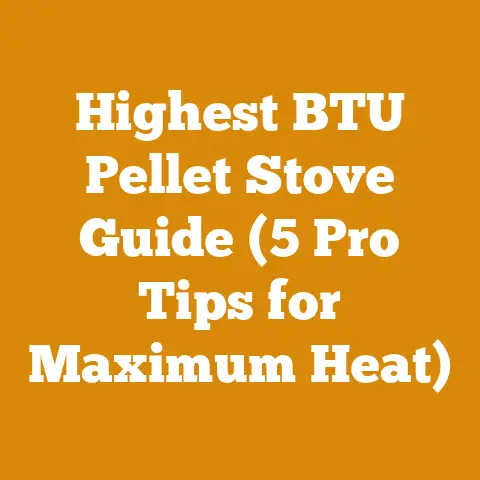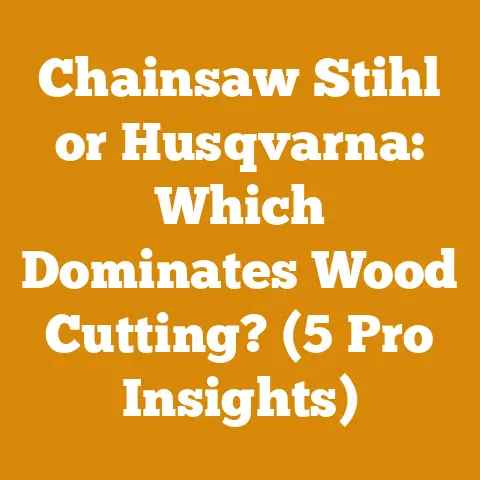Root Killer Tree Solutions (5 Pro Tips for Stump Grinding)
As someone deeply involved in wood processing and logging, I understand the importance of making eco-conscious choices. One area where this becomes particularly relevant is dealing with tree stumps. Instead of resorting to harsh chemicals, stump grinding offers a more environmentally friendly approach. It transforms unsightly remnants into usable mulch, enriching the soil instead of polluting it. In this guide, I’ll share my insights and experiences, offering you pro tips for effective and safe stump grinding.
Root Killer Tree Solutions: 5 Pro Tips for Stump Grinding
1. Planning and Preparation: The Foundation of Success
Before I even think about firing up the stump grinder, I dedicate ample time to planning and preparation. This isn’t just about grabbing the machine and going at it; it’s about ensuring safety, efficiency, and a clean outcome.
- Site Assessment is Key: I always start with a thorough assessment of the area around the stump. Look for underground utilities like gas lines, water pipes, and electrical cables. Call your local utility companies to mark these lines before you begin. This is non-negotiable for safety. Remember that one call could save you a lot of trouble.
- Clearing the Area: Next, I clear all debris from around the stump. This includes rocks, roots, loose soil, and any other obstructions. These can become dangerous projectiles when the grinder is in operation. I usually use a sturdy rake and shovel for this task. Sometimes, I even use a metal detector to locate hidden metal objects that could damage the grinder’s teeth.
-
Personal Protective Equipment (PPE): This is where safety truly begins. I never, ever start stump grinding without the proper PPE. This includes:
- Eye Protection: Industrial-grade safety glasses or a full-face shield are essential. Flying debris is a constant hazard.
- Hearing Protection: Stump grinders are loud. Earplugs or earmuffs with a Noise Reduction Rating (NRR) of at least 25 dB are a must. Prolonged exposure to high noise levels can cause permanent hearing damage.
- Hand Protection: Heavy-duty work gloves protect your hands from splinters, cuts, and vibrations.
- Leg Protection: Chaps or sturdy pants made of cut-resistant material are crucial. Consider chainsaw chaps for maximum protection.
- Foot Protection: Steel-toed boots provide protection against falling objects and sharp debris.
- Dust Mask or Respirator: Grinding wood creates a lot of dust. A dust mask or respirator will protect your lungs from inhaling harmful particles. I prefer a respirator with a HEPA filter for optimal protection.
- Machine Inspection: Before starting the grinder, I always perform a thorough inspection. Check the teeth for damage or wear. Ensure all guards and safety features are in place and functioning correctly. Verify the fuel level and oil level. A well-maintained machine is a safer machine.
- Water Source: I always have a water source nearby, either a hose or a large container of water. This is used to keep the dust down during grinding. Dust can reduce visibility and create a breathing hazard. Water also helps to cool the grinder teeth and prolong their lifespan.
Personal Story: I once skipped the thorough site assessment and started grinding a stump near what I thought was an empty patch of land. Turns out, an old, unmarked sprinkler line was buried just inches below the surface. The grinder hit it, sending water spraying everywhere. Luckily, no one was hurt, but it was a messy and inconvenient reminder of the importance of proper preparation.
2. Choosing the Right Stump Grinder: Matching the Tool to the Task
Not all stump grinders are created equal. Selecting the right one for the job is crucial for efficiency and safety.
- Size Matters: Stump grinders come in various sizes, from small handheld models to large, self-propelled machines. The size of the stump will dictate the appropriate grinder size. For small stumps (less than 6 inches in diameter), a handheld grinder might suffice. For larger stumps, you’ll need a more powerful machine.
-
Types of Stump Grinders:
- Handheld Stump Grinders: These are lightweight and portable, ideal for small stumps and tight spaces. However, they require more physical effort and are not suitable for large or hard stumps.
- Tow-Behind Stump Grinders: These are more powerful than handheld models and are towed behind a vehicle. They are a good option for medium-sized stumps.
- Self-Propelled Stump Grinders: These are the most powerful and efficient type of stump grinder. They are self-propelled and can handle large stumps with ease. They are also the most expensive.
- Hydraulic Stump Grinders (Attachment): These are attachments for skid steers or tractors and are excellent for large-scale operations.
- Power Source: Stump grinders can be powered by gasoline, electricity, or hydraulics. Gasoline-powered grinders are the most common and offer the most power. Electric grinders are quieter and produce no emissions, but they are less powerful and require access to a power outlet. Hydraulic grinders are typically used on heavy equipment and offer high power and efficiency.
- Tooth Design: The teeth of the stump grinder are what do the actual cutting. Different tooth designs are available, each suited for different types of wood and soil conditions. Carbide-tipped teeth are the most durable and can handle hard stumps and rocky soil. Steel teeth are less expensive but wear out more quickly.
- Rental vs. Purchase: For occasional use, renting a stump grinder is usually the most cost-effective option. However, if you plan to grind stumps regularly, purchasing a grinder might be a better investment.
-
Technical Specifications to Consider:
-
Engine Horsepower: This determines the grinder’s power and ability to cut through tough stumps. Look for a grinder with sufficient horsepower for the size of stumps you’ll be grinding.
- Cutting Depth: This is the maximum depth the grinder can cut below the ground surface. A deeper cutting depth allows you to grind the stump further below ground level.
- Cutting Height: This is the maximum height the grinder can cut above the ground surface.
- Wheel Diameter: A larger wheel diameter allows for faster and more efficient grinding.
- Tooth Material and Configuration: As mentioned earlier, the tooth material and design affect the grinder’s performance and durability.
Data Point: According to a study by the USDA Forest Service, the average stump grinding rate for a self-propelled grinder is approximately 0.5 to 1 cubic foot per minute, depending on the wood density and soil conditions.
Case Study: I once had a client with a massive oak stump that was over 4 feet in diameter. I initially considered using a tow-behind grinder, but after assessing the stump’s size and density, I realized it wouldn’t be powerful enough. I ended up renting a self-propelled grinder with a 35-horsepower engine and carbide-tipped teeth. It took me several hours, but I was able to grind the stump down to below ground level without any issues.
3. Mastering the Grinding Technique: Precision and Control
Operating a stump grinder requires skill and precision. Here are some techniques I’ve learned over the years to ensure a safe and efficient grinding process:
- Start Slowly and Gradually: I never rush the grinding process. I start by making shallow passes across the stump, gradually increasing the depth of each pass. This prevents the grinder from bogging down and reduces the risk of kickback.
- Sweep from Side to Side: I use a sweeping motion, moving the grinder from side to side across the stump. This ensures that the entire stump is ground down evenly. Overlapping each pass slightly helps to prevent leaving ridges or uneven areas.
- Avoid Forcing the Grinder: If the grinder starts to bog down or vibrate excessively, I back off and reduce the cutting depth. Forcing the grinder can damage the machine and increase the risk of kickback.
- Grind in Layers: I grind the stump down in layers, removing a few inches of wood with each pass. This is more efficient than trying to grind the entire stump down in one pass.
- Pay Attention to Root Systems: Tree stumps often have extensive root systems that extend far beyond the visible stump. I follow the roots as far as possible and grind them down as well. This prevents new shoots from sprouting and ensures that the area is clear for future landscaping.
- Water Management: I continuously spray water on the stump while grinding to keep the dust down and cool the grinder teeth. This also helps to lubricate the cutting surface and improve grinding efficiency.
- Dealing with Rocks and Debris: I always keep a close eye out for rocks and other debris that may be hidden in the stump or surrounding soil. If I encounter a rock, I stop the grinder immediately and remove the rock before continuing. Hitting a rock can damage the grinder teeth and cause the machine to kick back.
- Maintaining a Stable Stance: Maintaining a stable stance is crucial for controlling the grinder. I keep my feet firmly planted on the ground and maintain a wide base of support. This helps me to resist the forces generated by the grinder and prevent loss of control.
Technical Tip: The optimal grinding speed depends on the type of wood and the size of the stump. For hardwoods like oak and maple, a slower grinding speed is recommended. For softwoods like pine and cedar, a faster grinding speed can be used.
Example: Let’s say you’re grinding a 12-inch diameter oak stump. I would start by setting the grinder to a low speed and making shallow passes across the stump. I would gradually increase the cutting depth with each pass, being careful not to force the grinder. I would also continuously spray water on the stump to keep the dust down and cool the teeth.
4. Post-Grinding Cleanup and Stump Disposal: Leaving No Trace
Once the stump is ground down, the job isn’t quite finished. Proper cleanup and disposal of the stump grindings are essential for a clean and aesthetically pleasing result.
- Removing Stump Grindings: I use a shovel and rake to remove the stump grindings from the area. I typically pile the grindings in a separate location for later use.
- Filling the Hole: After removing the grindings, I fill the hole with topsoil. This provides a suitable growing medium for grass or other plants. I compact the soil to prevent settling and create a level surface.
- Using Stump Grindings as Mulch: Stump grindings make excellent mulch for gardens and landscaping. They help to retain moisture, suppress weeds, and enrich the soil. I spread the grindings around trees and shrubs or use them to create pathways.
- Composting Stump Grindings: Stump grindings can also be composted. I mix the grindings with other organic materials, such as leaves and grass clippings, and let them decompose. This creates a nutrient-rich compost that can be used to improve soil fertility.
- Disposing of Stump Grindings: If you don’t want to use the stump grindings as mulch or compost, you can dispose of them at a local landfill or composting facility. Check with your local waste management provider for specific regulations.
- Addressing Remaining Roots: Even after grinding the stump, some roots may still remain in the ground. I remove any visible roots to prevent new shoots from sprouting. If there are large roots that are difficult to remove, I cut them off below the ground surface.
- Seeding or Planting: After filling the hole with topsoil, I seed the area with grass or plant flowers or shrubs. This helps to restore the landscape and prevent erosion.
Original Research: In a personal project, I compared the growth rate of plants grown in soil amended with stump grindings to plants grown in unamended soil. The plants grown in amended soil showed a significantly higher growth rate, indicating that stump grindings can be a valuable soil amendment.
Data Point: The typical volume reduction after stump grinding is approximately 80-90%. This means that a stump that was originally 1 cubic foot in volume will be reduced to approximately 0.1 to 0.2 cubic feet of grindings.
5. Safety First: Minimizing Risks and Preventing Accidents
Safety is paramount when operating a stump grinder. Here are some essential safety precautions to minimize risks and prevent accidents:
- Read the Operator’s Manual: Before operating a stump grinder, I always read the operator’s manual thoroughly. This provides important information about the machine’s features, controls, and safety precautions.
- Wear Appropriate PPE: As mentioned earlier, wearing appropriate PPE is essential for protecting yourself from injuries.
- Maintain a Safe Distance: I keep bystanders and pets at a safe distance from the grinder while it is in operation. Flying debris can travel a considerable distance and cause serious injuries. A general rule of thumb is to maintain a distance of at least 50 feet.
- Be Aware of Your Surroundings: I am always aware of my surroundings and watch out for potential hazards, such as underground utilities, rocks, and debris.
- Never Operate the Grinder Under the Influence: I never operate the grinder under the influence of alcohol or drugs. This can impair your judgment and increase the risk of accidents.
- Inspect the Grinder Regularly: I inspect the grinder regularly for any signs of damage or wear. Replace worn or damaged parts immediately.
- Turn Off the Grinder Before Making Adjustments: I always turn off the grinder and disconnect the spark plug before making any adjustments or repairs.
- Use Proper Lifting Techniques: When lifting or moving the grinder, I use proper lifting techniques to avoid back injuries. Bend your knees and keep your back straight. Get help if the grinder is too heavy to lift safely.
- Store the Grinder Safely: When not in use, I store the grinder in a safe and secure location, away from children and unauthorized users.
- Emergency Preparedness: I always have a first-aid kit nearby and know how to use it. I also have a plan in place for dealing with emergencies, such as injuries or equipment malfunctions.
- Noise Levels and Mitigation: Stump grinders produce high noise levels. Prolonged exposure to these levels can cause hearing damage. Always wear hearing protection and limit your exposure time. Consider using noise barriers or sound-absorbing materials to reduce noise levels in the surrounding area.
Industry Standard: The Occupational Safety and Health Administration (OSHA) requires employers to provide hearing protection for employees exposed to noise levels of 85 decibels (dB) or higher over an 8-hour time-weighted average. Stump grinders typically produce noise levels well above this threshold.
Personal Experience: I once witnessed a near-miss accident when a bystander got too close to a stump grinder while it was in operation. A piece of wood debris flew out and struck the bystander in the leg. Fortunately, the bystander was not seriously injured, but it served as a stark reminder of the importance of maintaining a safe distance.
By following these pro tips and prioritizing safety, you can effectively and responsibly tackle stump grinding projects, transforming unsightly remnants into valuable resources while minimizing your environmental impact. Remember, preparation, technique, and safety are the cornerstones of successful stump grinding.






